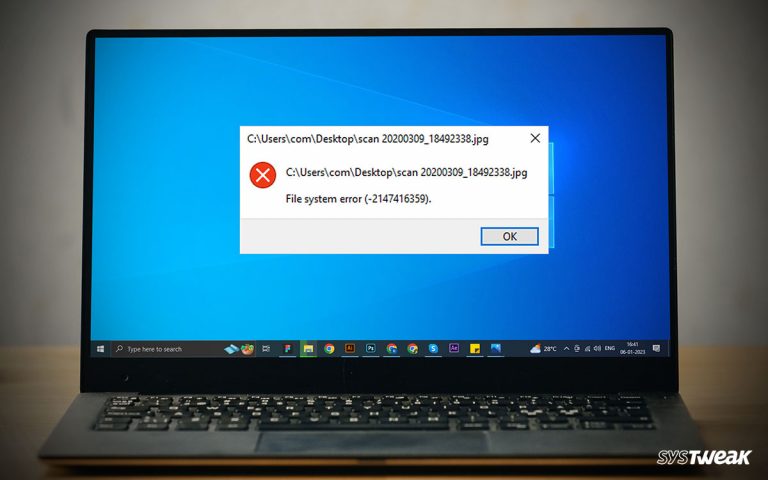Freeing up space on your hard drive seems a simple task but is quite the opposite. You must be aware of what type of files you have, which are helpful, and which ones are unnecessarily taking up the storage space. Ideally, if you need storage instantly, the best thing to do is to find large files on your hard drive and get rid of them.
50% OFF

BLACK FRIDAY OFFERS
Unlock Black Friday Mega Savings — Systweak Tools FLAT 50% OFF!
It’s not that simple! The biggest obstacle is finding apt files to delete in the first place. There are so many factors to consider before you start removing large files.
- Files Should not Affect the Working of Your PC.
- Large Files Should not Include System Files.
- Important Program Files for Software Should not be Deleted.
Now the question arises here: how to find the large files that can be deleted to recover space on Windows 10 PC? Well, if your hard drive is full, make sure you read this post till the end; as in this one, we will discuss a few effective ways you can use to search and highlight large files from your computer. Without further ado, let’s jump right into them!
Ways to Find Large Files in Windows 10: Recover Storage Space Instantly
Depending on your approach, looking for large files on your PC can be simple and tough. Some ways may require you to spend time, and then some techniques can do the job for you while you have to do nothing. Let’s go through all of them one by one and find out which of them can yield the best results.
Method 1 – Search for ‘Gigantic’ Files Using Windows Explorer
To find large files on windows 10, you can run Windows Explorer, click on the search bar at the top right corner, and type size: This will give a drop-down for you to select a size bracket. Simply choose the desired size and let the explorer search for files. To provide you with a better perspective, here’s a step-by-step guide to help you with this method –
- Open Windows Explorer

- Navigate to ‘This PC’

- Find the Search Bar on the Right Corner.

- Click on the Search Bar and type Size:

- Select the Size Bracket By Clicking on it & Initiate the Search.
With these five steps, you can get all the large files on your computer. The only downside you may feel for the method is that it lists all the system files. Your Windows security and functionality files are exposed. Deleting them can hamper the computer’s functioning, and thus you have to be careful.
Method 2 – Use Command Prompt to Enlist Large Files
Another way to find all the large files on your PC is by using a Command Prompt, commonly known as cmd. Here are the steps to execute while implementing this method to find large files on Windows 10 –
- Press Windows + R on your keyboard to initiate RUN.
- Type in – cmd and press enter to make bring up Command Prompt.

- Use Command – forfiles /S /M * /C “cmd /c if @fsize GEQ 1073741824 echo @path > largefiles.txt and press enter.

- Let the command fetch results by evaluating the entire hard drive.
- By the end of the process, you will find a text file named ‘largefiles.txt.’ It is a list of all the large files along with their destination.

The limitation of this approach is that you will have to find the files once you know the path manually. This is a time-consuming process. Not to mention, the risk of accidentally removing system files is still present.
Method 3 – Use Third-Party Storage Optimizer Applications
Last, you can install Advanced Storage Management and Optimizer tools on your computer. These highly robust applications search through the entire PC and give you insights into what is occupying space on your PC.
The best out of all the options available in the market right now is Advanced System Optimizer. Simply run the application on your computer, and the software will not only find all the unnecessary files for you but will also allow you to delete them instantly.
The Advanced System Optimizer Works in 7 Easy Steps –
- Download and Install Advanced System Optimizer on Your PC.
- Run the Application and Find all the Options for PC optimization.

- Click on Disk Cleaner & Optimizers to find More Disk Cleaning Options.

- Click on System Cleaner to Optimize Your Disk Space and remove Unnecessary Files. A pop-up appears that gives you access to System Cleaner. Click on Scan Now to Initiate Your PC scanning.

- Once the scan is completed, the application shows you a report that consists of how many files you can delete. It lists out all the clutter, which includes large, medium, and small files that matter.

You can click on the view details tab to know more about the files and types of files.

- Click on Clean System to Delete All the Unnecessary Files. The process takes place in three steps.
- Step 1 is to create a restore point. It helps in recovering an ideal state if anything goes wrong.
- Step 2 is to remove all the unwanted files, create space on your hard drive, and optimize your storage.
- Last but not least, Step 3 tries to fix the issues you were facing due to the hard drive being out of capacity.

- Once the process is completed, you will find free disk space on your hard drive.
The best part of using the tool is that it not only helps you find large files on Windows 10 but also gives you a way to distinguish between system files and unwanted files. The software does not require a lot of user intervention as it uses an automated process, which makes it better than both methods mentioned above.
Parting Words
Using the methods mentioned above, you can find large files on Windows 10 and free your hard drive to retrieve usable space. Going for any of these methods can work If you only want space. However, if you optimize your disk usage, recover hard disk space, and optimize your PC performance, then an Advanced System optimizer is the way to go.
If you have any other suggestions to add on how to find large files on Windows 10, feel free to drop them down in the comments. Thanks for reading. Good Luck!
Recommended-
- How To Identify and Remove Bloatware?
- How to Uninstall OneDrive on Windows 10 – OneDrive Uninstaller
- Windows 11 Keeps Crashing? How To Fix It
- How to Free Up Space in Windows 11,10





